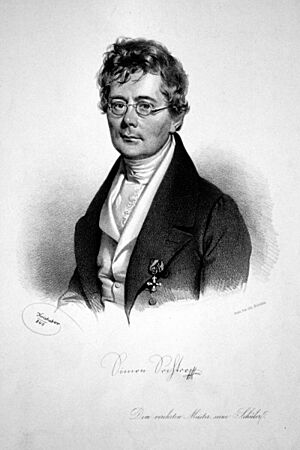Simon Sechter facts for kids
Simon Sechter (born October 11, 1788 – died September 10, 1867) was an important Austrian musician. He was a music theorist, a teacher, an organist, a conductor, and a composer.
Sechter wrote a lot of music, more than almost anyone else! But today, people mostly remember him as a very strict music teacher. His most famous student was Anton Bruckner. During his life, famous composers like Beethoven, Schubert, and Schumann admired his teaching.
An American musician named Carl Christian Müller later put together and changed one of Sechter's books. It was called The Correct Order of Fundamental Harmonies and was published in 1871.
Simon Sechter's Life Story
Sechter was born in a place called Friedberg (now Frymburk) in Bohemia. At that time, Bohemia was part of the Austrian Empire. In 1804, he moved to Vienna, a big city in Austria.
In 1810, he started teaching piano and singing at a school for students who were blind. Later, in 1824, he became the court organist in Vienna, taking over from another musician named Jan Václav Voříšek.
In 1828, the famous composer Franz Schubert took one music lesson with Sechter. In 1851, Sechter became a professor of composition at the Vienna Conservatory, which is a famous music school.
Sechter faced some financial difficulties in his later years. After he passed away, his former student Anton Bruckner took over his teaching job at the Conservatory. Bruckner used many of Sechter's teaching ideas.
How Sechter Taught Music
Simon Sechter taught many students who became famous musicians. Some of them include Henri Vieuxtemps, Franz Lachner, and Eduard Marxsen. Marxsen later taught Johannes Brahms how to play piano and understand music theory.
Sechter was known for his very strict teaching methods. For example, he told his student Anton Bruckner not to write any of his own music while he was learning from him. A music expert named Robert Simpson thought that by making Bruckner hold back, Sechter actually helped him become more original later on.
Sechter taught Bruckner through letters from 1855 to 1861. He considered Bruckner his most dedicated student. When Bruckner finished his studies, Sechter even wrote a special fugue (a type of musical piece) just for him.
Sechter also wrote a very important three-volume book about how to compose music. It was called Die Grundsätze der musikalischen Komposition. This book influenced many music theorists who came after him. Sechter's ideas were based on earlier theories about how musical notes fit together. He also believed that music should be tuned in a very specific way, called just intonation.
Sechter as a Composer
Besides being a teacher, Simon Sechter was also a very active composer. He is most famous for writing about 5,000 fugues! He tried to write at least one fugue every day.
He also composed many other types of music, including masses (music for church services) and oratorios (large musical works for voices and orchestra). Sechter wrote five operas too, which are musical plays. Some of their names were Das Testament des Magiers and Melusine.
In 1823 and 1824, Sechter was one of 51 composers who wrote a variation on a waltz by Anton Diabelli. This collection of music was called Vaterländischer Künstlerverein.
Images for kids



